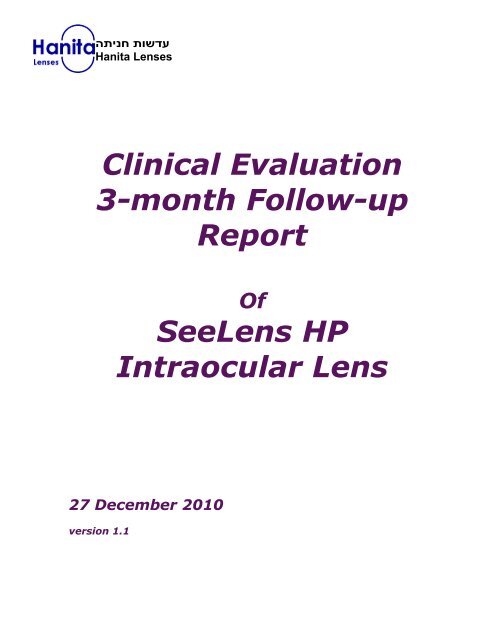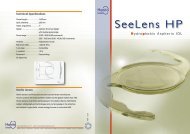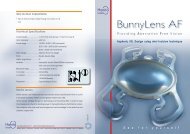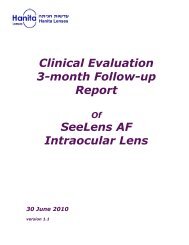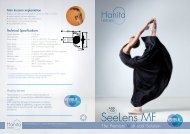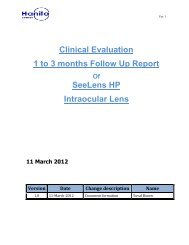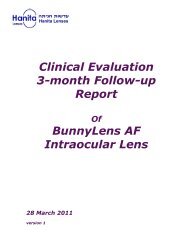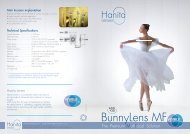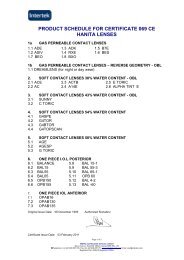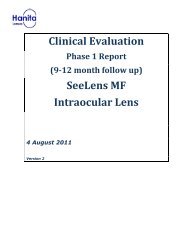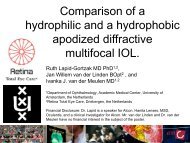Clinical Evaluation 3-month Follow-up Report Of ... - Hanita Lenses
Clinical Evaluation 3-month Follow-up Report Of ... - Hanita Lenses
Clinical Evaluation 3-month Follow-up Report Of ... - Hanita Lenses
- No tags were found...
Create successful ePaper yourself
Turn your PDF publications into a flip-book with our unique Google optimized e-Paper software.
עדשות חניתה<strong>Hanita</strong> <strong>Lenses</strong>3of 16Medical Device Specification and AdministrationSpecifications1. Device descriptionThe SeeLens HP is an aspheric asymmetric intraocular lens, which is CE marked since 2009.SeeLens HP SpecificationsOptic Diameter 6.0 mmPower range+10 to +30 (0.5 increments)+30 to +40 (1.0 increments)Optic design Asymmetric Bi convex aspheric lensLens designDouble square edge with steppedbarrierHapticangulation7ºMaterial BENZ HF1 NATURAL YELLOWRefractive index 1.485 (35º c)YAG laser CompatibleA constant 119.5PlacementInjection –incision sizeCapsular bag2.4 mm incision<strong>Hanita</strong> <strong>Lenses</strong> Intraocular & Contact <strong>Lenses</strong>עדשות חניתהעדשות מגע ועדשות השתלה תוך-עינית•קיבוץ חניתה • 88885 www.hanitalenses.com Kibbutz <strong>Hanita</strong> 22885 Israel • Tel. 972-4-9950 700• Fax: 972-4-9950 755 •
עדשות חניתה<strong>Hanita</strong> <strong>Lenses</strong>4of 16Figure 1: SeeLens HP Intraocular lens2. SeeLens HP designa. Motivation – visual acuity<strong>Hanita</strong> <strong>Lenses</strong> search for vision quality improvements has a shared objective for bothrefractive and cataract surgery. The main goal for the refractive and cataract surgery is toprovide the patient with the best visual acuity and good post operative refraction that currenttechnology allows.The quest for an improved visual acuity for the cataract patient led <strong>Hanita</strong> <strong>Lenses</strong> to developan aspheric-shaped lens. Designed to allow the patient a sharper image in the regular photopicvision (daylight vision), and reduce the aberrations of mesopic and scotopic vision (twilightand night vision), which are noticed by some of the conventional spherical Intra Ocular Lensimplanted patients.<strong>Hanita</strong> <strong>Lenses</strong> Intraocular & Contact <strong>Lenses</strong>עדשות חניתהעדשות מגע ועדשות השתלה תוך-עינית•קיבוץ חניתה • 88885 www.hanitalenses.com Kibbutz <strong>Hanita</strong> 22885 Israel • Tel. 972-4-9950 700• Fax: 972-4-9950 755 •
עדשות חניתה<strong>Hanita</strong> <strong>Lenses</strong>5of 16Figure 2:The Black line defines the photopic vision and the green line defines the scotopic vision.The area between the graphs defines the scotopic vision.b. Hydrophobic material – preventing PCO:The SeeLens HP is made of hydrophobic acrylic material, which is known to be s<strong>up</strong>erior inpostponing the posterior capsular opacification (PCO), thus reducing the need for the YAGlaser treatment. Moreover, hydrophobic materials are known to be more stable within theposterior capsule with respect to the hydrophilic lenses due to its higher stiffness with respectto the hydrophilic acrylic material. The SeeLens HP aspheric optical design is identical to theSeeLens AF, <strong>Hanita</strong> <strong>Lenses</strong>’ premium product. The SeeLens HP is made of a different rawmaterial, BENZ HF-1 Natural Yellow. This material has chemical composition very similar tothe backbone structure of the BENZ IOL 25 Natural Yellow material.c. Spherical aberration:The spherical aberration is a well known phenomenon in the optic field. The sphericalaberration occurs when rays of light that pass through different parts of the lens intersect atdifferent points on the optical axis of the lens (Figure 3). Due to this aberration, a dotprojected on the retina produces a larger circle, thus inducing low quality optics, an unclearvision and low contrast (Figure 4).Figure 3:Spherical AberrationFigure 4:A demonstration of the blur caused by spherical aberration with awider p<strong>up</strong>il. The rays that enter the retina from far scatter differentlyand are projected blurredly to the retina, causing a law quality image.Contributors to spherical aberration (SA) in the eye are the cornea (average +0.27 m) and thecrystalline lens (negative in the young eye). Cataract surgery removes the lens component andleaves positive SA on average. Traditional intraocular lenses (IOLs) are spherical withpositive SA, further increasing the SA of the pseudophakic eye.<strong>Hanita</strong> <strong>Lenses</strong> Intraocular & Contact <strong>Lenses</strong>עדשות חניתהעדשות מגע ועדשות השתלה תוך-עינית•קיבוץ חניתה • 88885 www.hanitalenses.com Kibbutz <strong>Hanita</strong> 22885 Israel • Tel. 972-4-9950 700• Fax: 972-4-9950 755 •
עדשות חניתה<strong>Hanita</strong> <strong>Lenses</strong>6of 16d. <strong>Clinical</strong> demand:As it gets darker and the p<strong>up</strong>il dilates, the spherical aberration becomes more apparent, andstarts to be noticeable by the patient. Thus patients with conventional spherical lensescomplain of unclear vision and poor contrast in the mesopic and scotopic conditions.e. Influence of tilt and decentrationThe SeeLens HP is based <strong>up</strong>on the mechanical design of SeeLens AF IOL. The SeeLens AFdesign was proven to have good stability and good resistance to tilt and centration as well.Moreover, the SeeLens HP Optical design was demonstrated by the ZEEMAX to have goodresilience in terms of tilt and decentration as presented in the attached graph.Figure 7: The influence of the degree of Tilt on the resultant MTFFigure 8: The influence of the degree of Tilt on the resultant MTF3. Surgical ProcedureThe study Surgery Procedure: cataract extraction by ECCE Phacoemolsification. Operationwas performed according to the routine surgery technique of the investigative sites.The surgical procedure was conducted according to protocol.<strong>Hanita</strong> <strong>Lenses</strong> Intraocular & Contact <strong>Lenses</strong>עדשות חניתהעדשות מגע ועדשות השתלה תוך-עינית•קיבוץ חניתה • 88885 www.hanitalenses.com Kibbutz <strong>Hanita</strong> 22885 Israel • Tel. 972-4-9950 700• Fax: 972-4-9950 755 •
עדשות חניתה<strong>Hanita</strong> <strong>Lenses</strong>Methods7of 16Sample size: a study of 20 patients, who meet the inclusion / exclusion criteria for the study protocol.The study was carried out starting from July 2010.The Investigative sites were:SiteDr. J. NovakRegional HospitalPradubice,Czech republicNumber ofimplanted eyesNumber of eyes3 <strong>month</strong>s follow <strong>up</strong>20 19Statistical MethodsThe following analyses were used to describe the data in this report:1. Descriptive statistics: continuous variables are described with mean ± standard deviation(SD), median, minimum and maximum. Nominal scale variables are described withabsolute and relative (percents) frequencies. Ordinal variables are described with means ±SD and frequencies of the ordinal grades.2. Comparisons between pre and post operative variables were done with paired-samples t-test. The critical level of significance is α=0.05.3. All analyses were done using Excel 2007 statistics tool package.<strong>Hanita</strong> <strong>Lenses</strong> Intraocular & Contact <strong>Lenses</strong>עדשות חניתהעדשות מגע ועדשות השתלה תוך-עינית•קיבוץ חניתה • 88885 www.hanitalenses.com Kibbutz <strong>Hanita</strong> 22885 Israel • Tel. 972-4-9950 700• Fax: 972-4-9950 755 •
עדשות חניתה<strong>Hanita</strong> <strong>Lenses</strong>Results8of 16a. IOL Performance During ImplantationImplantation parameters were measured to indicate the performance of the SeeLens HP IOLimplantation during the standard cataract surgery. The implantation parameters that weremeasured during the implantation were SeeLens HP handling, folding, implantation,unfolding, need to manipulate the lens and the final centration and tilt of the lens position atthe end of the procedure.All parameters were graded on a 0 (best) to 4 (worst) scale, results are presented in Graph 1.Graph 1: IOL Performance During ImplantationAs can be seen in graph 1, the surgeon reported that the SeeLens HP handling, folding andimplantation are easy and smooth. Moreover, no difficulties in IOL positioning and centrationwere reported.The biggest score was observed in grading of unfolding. The unfolding in hydrophobic IOLsis known to be slower than hydrophilic IOLs. After collecting clinical data from dozens ofSeeLens HP implantations, a new method for folding was developed in “<strong>Hanita</strong> <strong>Lenses</strong>”. Thismethod caused a significant reduction in unfolding time as well as solving any stickingproblem.<strong>Hanita</strong> <strong>Lenses</strong> Intraocular & Contact <strong>Lenses</strong>עדשות חניתהעדשות מגע ועדשות השתלה תוך-עינית•קיבוץ חניתה • 88885 www.hanitalenses.com Kibbutz <strong>Hanita</strong> 22885 Israel • Tel. 972-4-9950 700• Fax: 972-4-9950 755 •
עדשות חניתה<strong>Hanita</strong> <strong>Lenses</strong>b. IOL location and centration9of 16Lens location and centration were noted and reported in all follow-<strong>up</strong> visits. Centration andtilt were graded on a 0 (best) to 4 (worst) scale. See protocol for more details.All lenses during follow <strong>up</strong> visits including 3 <strong>month</strong>s follow-<strong>up</strong> were reported as zero (Best)centration and tilt.On top of that, on a scale of 0-4 for clarity, all lenses were reported as zero (Best).Therefore, the SeeLens HP demonstrated good stability and centration from implantationthroughout the 3 <strong>month</strong> follow-<strong>up</strong> period.c. Post-operative Best Corrected Visual Acuity (BCVA)Best Corrected Visual Acuity (BCVA) was reported in the pre-operative and the three <strong>month</strong>follow-<strong>up</strong> visit. Pre-operative BCVA results are shown on Graph 2, and Post-operativeBCVA results are shown on Graph 3.Graph 2: Pre-operative BCVA distribution<strong>Hanita</strong> <strong>Lenses</strong> Intraocular & Contact <strong>Lenses</strong>עדשות חניתהעדשות מגע ועדשות השתלה תוך-עינית•קיבוץ חניתה • 88885 www.hanitalenses.com Kibbutz <strong>Hanita</strong> 22885 Israel • Tel. 972-4-9950 700• Fax: 972-4-9950 755 •
עדשות חניתה<strong>Hanita</strong> <strong>Lenses</strong>Graph 3: 3-<strong>month</strong> Post-operative BCVA distribution11of 16* 3 <strong>month</strong>s post OP BCVA of one patient from was not received (total of 19 patients).As shown in graph 3, postoperative (3 <strong>month</strong>s) BCVA of 6/8 or better was reported in 100%of the eyes.Pre and post-operative BCVA are compared in Table 1:Table 1: Pre-operative BCVA vs. Post-operative BCVAMesuredparameterAverageStandardDeviationPre Op BCVA 0.54 (6/11) ±0.25Post Op BCVA 0.99 (6/6.07) ±0.05<strong>Hanita</strong> <strong>Lenses</strong> Intraocular & Contact <strong>Lenses</strong>עדשות חניתהעדשות מגע ועדשות השתלה תוך-עינית•קיבוץ חניתה • 88885 www.hanitalenses.com Kibbutz <strong>Hanita</strong> 22885 Israel • Tel. 972-4-9950 700• Fax: 972-4-9950 755 •
עדשות חניתה<strong>Hanita</strong> <strong>Lenses</strong>d. Intraocular Pressure Changes11of 16Changes in intraocular pressure (IOP) from the pre operative to 3-<strong>month</strong> postoperative visitare shown in graphs 5-6 below.Graph 5: Pre operative IOP pressureGraph 6: Post operative IOP pressure* Post operative IOP of one patient was not received (total of 19 patients).IOP remained within the normal range (7mmHg - 21mmHg) with in population in 100% ofthe eyes.A decrease of the intra ocular pressure was observed in the comparison of the pre operativeIOP to post operative IOP.<strong>Hanita</strong> <strong>Lenses</strong> Intraocular & Contact <strong>Lenses</strong>עדשות חניתהעדשות מגע ועדשות השתלה תוך-עינית•קיבוץ חניתה • 88885 www.hanitalenses.com Kibbutz <strong>Hanita</strong> 22885 Israel • Tel. 972-4-9950 700• Fax: 972-4-9950 755 •
עדשות חניתה<strong>Hanita</strong> <strong>Lenses</strong>18of 16Table 3: Pre operative IOP vs. Post operative IOPMeasuredStandardAverageparameterDeviationPre Op IOP[mmHg]15.89 ±2.62Post Op IOP[mmHg]14.95 ±2. 3Change in IOP -0.95 ±2.97<strong>Hanita</strong> <strong>Lenses</strong> Intraocular & Contact <strong>Lenses</strong>עדשות חניתהעדשות מגע ועדשות השתלה תוך-עינית•קיבוץ חניתה • 88885 www.hanitalenses.com Kibbutz <strong>Hanita</strong> 22885 Israel • Tel. 972-4-9950 700• Fax: 972-4-9950 755 •
עדשות חניתה<strong>Hanita</strong> <strong>Lenses</strong>e. Intra-operative <strong>Report</strong>13of 161. Incision Size – from total of 20 IOLs, 3 were implanted using a 2.2mm incision sizecartridge and 17 lenses were implanted using a 2.4 mm incision size cartridge.Graph 7: Cartridge size<strong>Hanita</strong> <strong>Lenses</strong> Intraocular & Contact <strong>Lenses</strong>עדשות חניתהעדשות מגע ועדשות השתלה תוך-עינית•קיבוץ חניתה • 88885 www.hanitalenses.com Kibbutz <strong>Hanita</strong> 22885 Israel • Tel. 972-4-9950 700• Fax: 972-4-9950 755 •
עדשות חניתה<strong>Hanita</strong> <strong>Lenses</strong>f. Adverse Events as defined by ISO 11979-7 200114of 16Adverse EventMaximal allowablerate as defined byISO 11979-7 2001 ;100 subjectsScore / measurementRate ofadverseeffectoccurred atthis studyPass/FailCystoid macular 6% No / Yes 0 % PassoedemaHyphema 5% 0 1 2 3 4 0% PassHypopyon 1% Measure in mm. 0% PassIntraocular 1% 0% PassinfectionLens dislocation 1% Measure in mm. 0% PassP<strong>up</strong>illary block 1% No / Yes 0% PassRetinaldetachmentSecondarySurgicalintervention(eccluding retinaldetachment andposteriorcapsulotomy)1% No / Yes 0% Pass2% No / Yes, specify 0% PassCorneal stroma 1% 0 1 2 3 4 0% PassoedemaCystoid macular 2% No / Yes 0% PassoedemaIritis 1% 0 1 2 3 4 0% PassRaised IOP req.treatment2% 0% PassAs shown in table 3, no adverse event was reported in 100% of SeeLens HP implanted eyes,in a sample size of 20 patients.Thus, it can be concluded that the SeeLens HP’s safety is fully in accordance to the ISO11979-7 2001This information s<strong>up</strong>ports the conclusions that were previously presented, and reassures thatthe SeeLens HP is a safe high quality predictable lens.<strong>Hanita</strong> <strong>Lenses</strong> Intraocular & Contact <strong>Lenses</strong>עדשות חניתהעדשות מגע ועדשות השתלה תוך-עינית•קיבוץ חניתה • 88885 www.hanitalenses.com Kibbutz <strong>Hanita</strong> 22885 Israel • Tel. 972-4-9950 700• Fax: 972-4-9950 755 •
עדשות חניתה<strong>Hanita</strong> <strong>Lenses</strong>15of 16ConclusionsThe detailed data from the current study on 20 eyes shows the benefits of the SeeLens HPIOL:Optical performance is in accordance to ISO 11979-7 requirements.The safety of the lens is demonstrated, as no adverse events and complicationswere reported.<strong>Hanita</strong> <strong>Lenses</strong> Intraocular & Contact <strong>Lenses</strong>עדשות חניתהעדשות מגע ועדשות השתלה תוך-עינית•קיבוץ חניתה • 88885 www.hanitalenses.com Kibbutz <strong>Hanita</strong> 22885 Israel • Tel. 972-4-9950 700• Fax: 972-4-9950 755 •


